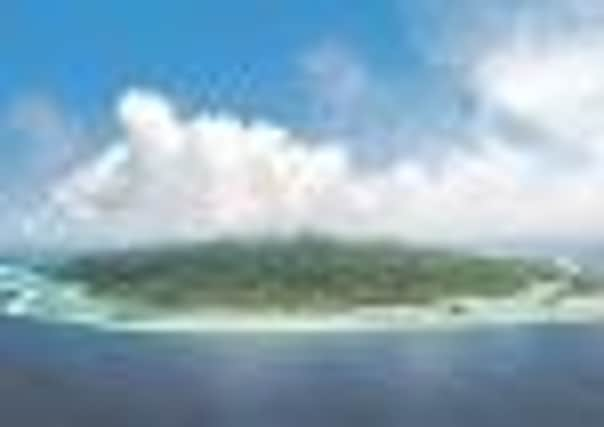Travel: Cook Islands


However, while the trip is a lengthy one, it doesn’t take more than a few moments after arrival to know it has been journey time very well spent.
My island welcome started as soon as I stepped from the plane at 5.30am, when I was greeted by veteran entertainer Jake Numanga with a Frank Sinatra classic while I waited for my luggage. Incredibly, for more than 20 years, day and night, everyone arriving and departing on a long-haul flight has been serenaded by Jake, his ukulele and his distinct island sound.
Advertisement
Hide AdBreathing in the balmy island air and heady scent from the lei of frangipani flowers draped around my neck, hearing the crash of the ocean and seeing the coconut palms silhouetted against the red morning sky, the lengthy journey was soon a distant memory.
This is Rarotonga. At 20 miles in diameter, it is the largest of the Cook Islands and a South Seas paradise of craggy hillsides, dense, lush jungle, empty white sand beaches and turquoise seas. Only a delicate barrier of coral reef stops the Pacific from crashing angrily onto the sandy shores, ensuring the waters immediately surrounding the island remain calm and ideal for snorkelling – a must-do activity, as the water is teeming with colourful fish.
Stepping from my villa on to the white sands, strewn with the odd washed-up coconut, it is a 30-minute stroll before I come across another soul. However, when you do encounter the friendly folk of Rarotonga, you’ll find that, more than anything, they like to chat. Tell them you’ve travelled from Scotland and you’re also likely to find that many are keen to share details of a surprising branch of their family tree.
Like people of Polynesian descent, islanders here are familiar with their heritage stretching back to when the islands were first populated, in 800AD. On discovering I’d travelled from Edinburgh, one local shopkeeper told me he was the descendent of a Scots sailor with the surname Gregg. Then there was Bill Rennie, the owner of the luxurious Royale Takitumu Villas, who was grateful to his great-grandfather, Captain James Rennie, for making the arduous journey to the South Pacific. As we chatted in the tropical gardens surrounding the distinctive thatched beachside villas, Rennie considered that life might have been very different had Captain Rennie remained in his native Kirkcaldy.
Meanwhile, Jim Bruce, my gregarious Hawaiian host at the Aro’a Beachside Inn, was also proud of his Scots heritage and threatened a blast of the bagpipes if I turned up late for his special Sunday-morning omelette breakfast.
While the islands take their name from Captain James Cook, who caught sight of them as he sailed by in 1773, it is the legacy of Christian missionaries that you’ll find everywhere on the island. These days, incredibly, there are 30 churches on Rarotonga alone, serving a population of just 10,000.
Advertisement
Hide AdOne such man of God was the ill-fated James Chalmers – a friend of Robert Louis Stevenson – who moved from his Argyll home to Rarotonga in 1867, determined to persuade the native islanders to give up drinking, polygamy and cannibalism in favour of Christianity.
Chalmers really should have stayed on Rarotonga, where he became popular, because, when he moved to New Guinea he met a truly gruesome end at the hands of the cannibals he was seeking to convert.
Advertisement
Hide AdThe Cooks are made up of 15 islands, occupying a total landmass of less than 100 square miles, scattered across a vast expanse of Pacific Ocean the size of western Europe.
Rarotonga itself is a landscape of striking contrasts. Steeply rising from the oh-so-empty sandy, coconut-fringed beaches is the island’s lush jungle, culminating in verdant angular summits that walkers can explore via a network of paths that criss-cross the island.
One of the island’s most famous walking guides is the spiritual Pa, a 71-year-old who accompanied me to Te Rua Manga, or the Needle. As you clamber up the steep slope, using tangled tree roots as a ladder to propel yourself skywards, Pa insists on silence – a meditation to heighten appreciation of the surrounding countryside.
This breath-saving move was a wise one, I thought, as I puffed my way up the steep incline, Pa’s mass of bleached dreadlocks fast disappearing ahead of me. However, when we came to rest on a rock with a glorious view of the pinnacle up ahead, he was keen to answer questions about his spirituality and experience as a local medicine man. Attributing his youthful looks to being at one with nature, he also told me that, while his home was very much in Rarotonga, his heart was firmly in Aberdeen, the Scots city where his son was studying medicine.
While there is lots to explore on Rarotonga – whether by kayak, on foot or by hiring a scooter to zoom along the island’s ring road – it would be a shame if you didn’t just sit back and enjoy the island’s tranquillity and striking beauty. One morning, I was lucky enough to spy a tall plume of water and then the flip of a tail as a whale plunged back under the ocean. Really, there was a great deal to be gained from stretching out in a hammock and being hypnotised by the waves crashing on to the reef.
I also fleetingly found myself wondering where all the people were. The presence of other holidaymakers was occasional, adding to the indulgence of feeling like a castaway in my own piece of heaven. I was 10,000 miles from Scotland and in no doubt at all that the Cook Islands were a place well worth travelling to the other side of the world for. n